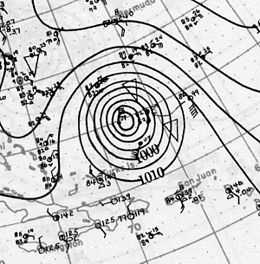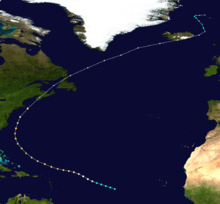1927 Nova Scotia hurricane
| Category 3 major hurricane (SSHWS/NWS) | |
 Surface weather analysis of the hurricane on August 22 | |
| Formed | August 19, 1927 |
|---|---|
| Dissipated |
August 29, 1927 (extratropical after August 25) |
| Highest winds |
1-minute sustained: 125 mph (205 km/h) |
| Lowest pressure | 950 mbar (hPa); 28.05 inHg |
| Fatalities | 184 direct |
| Damage | $1.1 million (1927 USD) |
| Areas affected | New England, Atlantic Canada |
| Part of the 1927 Atlantic hurricane season | |
The 1927 Nova Scotia hurricane (also known as the 1927 Great August Gale or the Great Gale of August 24) was a powerful Category 3 hurricane that struck the Canadian province of Nova Scotia in mid-August 1927. The first major hurricane of the 1927 Atlantic hurricane season, the storm struck Atlantic Canada as a powerful extratropical storm with winds at 100 mph (161 km/h) where it caused severe damage and left 184 fatalities (mostly at sea).[1]
Storm history

A possible Cape Verde type hurricane, the storm was detected on August 21, 300 miles (480 km) east of the Leeward Islands (it had already reached hurricane status on August 19).[2][3] Warmer waters in the Atlantic Ocean allowed the hurricane to rapidly reach Category 3 status on August 22 and a ship reported a barometric pressure of 28.06 inches (950 millibars). The hurricane moved northwestward at a speed of 25 mph (40 km/h) before recurving on August 23. With the center 100 miles (161 km) east of North Carolina, the hurricane moved northeast where it bypassed Nantucket by 100 miles (161 km). The hurricane then made landfall in Nova Scotia on August 24 as a strong extratropical storm with 100 mph (161 km/h) winds. Later the extratropical remnants of the hurricane were tracked as far north as Iceland.[3][4]
Preparations
Shipping ahead of the hurricane received repeated warnings broadcast by both the U.S. and Canadian weather officials. Small craft warnings and a hurricane warning for New York City were also issued.[3] However the majority of fishing vessels in Atlantic Canada in this period did not have radios, leaving the large fishing fleet on the offshore banks unaware of the approaching disaster.[5]
Impact
Because of the fast forward speed of the hurricane, the damage was minimal in New England. However, the hurricane was devastating in Atlantic Canada as the storm caused tremendous damage and 184 deaths (mostly at sea). The hurricane's impact was the worst for Atlantic Canada in over a half a century.
New England
Rainfall from the hurricane caused moderate flooding in New England. Most of the flooding occurred in central Massachusetts. In Maine, dense fog was reported and rainfall up to 2 inches (50.8 mm) fell across the state. The rainfall caused isolated street flooding. In Eastport, Maine a weather station reported a low pressure of 29.04 inches (983 millibars). There were no fatalities and damage in Maine was minimal.[4] Offshore, the hurricane damaged a fishing ship leaving one dead and three injured.[6]
Atlantic Canada
Nova Scotia received heavy rainfall up to 4 inches (102 mm) and gale force winds. In the Annapolis Valley, the rainfall fell so quickly that drainage ditches and small creeks overflowed. The flooding washed out 20–25 percent of the rail lines across Nova Scotia, disrupting rail service. Flooding also damaged numerous roads and swept away bridges making traveling difficult. Crop damage from the hurricane was severe as the storm destroyed 50 percent of the fruit, vegetable and hay harvest. Crop damage from the storm amounted up to $1 million (1927 USD). Other parts of Nova Scotia received similar damage. In Lakeville, Nova Scotia, flooding washed away a 25-foot (7.6 m) bridge, and fallen trees and other storm debris littered the streets and roads. The Cornwallis River, overflowed its banks, causing serious flash flooding. Tree and bridge damage were also reported throughout Nova Scotia. [7]
The village hardest hit by the hurricane was Harbourville, Nova Scotia and adjacent settlements along the "Bay Shore" coastline of the Bay of Fundy.[8] There the hurricane completely destroyed a gravel road which had been built shortly before the storm's impact. Another road connecting to a hotel was also severely damaged. Heavy rainfall brought by the hurricane caused landslides and flooding along the Harbourville Mountain which washed out numerous roads. Near Harrington’s Crossing, a small creek overflowed its banks, stalling numerous automobiles.[7]
Offshore, seventy-five fishing boats of the Lunenburg fishing fleet were reported missing in the Grand Banks.[7] Of the seventy-five, four vessels were reported as total losses.[9] The Joyce Smith and Clayton Walters were the first two fishing vessels to fall victim to the hurricane. The Joyce Smith was carrying 22 men (mostly from Newfoundland) and it and the Walters were fishing off the coast of Sable Island at the time of the hurricane. The last sighting of the two fishing boats was from the crew of the Marshall Frank 27 miles (43 km) off Sable Island. Newspaper reports suggested that both fishing boats did not survive the storm and all 43 crewmen perished at sea.[10]
The Mahala, another fishing schooner, was also listed among the ships missing after the hurricane. A search in the area where the ship was reported missing turned up nothing and it was assumed that the ship sank along with its eighteen fishermen.[11]
The fourth fishing boat to be reported missing was the Uda R. Corkum[12] which was carrying a crew of 21 crew men and 1800 quintals of fish. In all, the loss from all four vessels totaled up to 80 and monetary losses from all four ships totaled over $100,000 dollars (1927 USD)[13] Four more fishing boats also sank during the hurricane, taking 33 lives.[14]
In addition to the Canadian fishing boats, the famous U.S. racing and fishing schooner Columbia[15] carrying 22 crew men (many from Nova Scotia) sank during the storm off the coast of Sable Island. There were no survivors.[16]
Legacy
The Hurricane of 1927 followed another tragic August storm the previous year and together they became known as "The August Gales", remembered for generations as one of the worst tragedies in the fisheries of Maritime Canada. The severe shipping losses, especially among banks fishing schooners, accelerated a move to outfit Canadian schooners with motors and radios.[17] Today the Hurricane of 1927 is commemorated in a waterfront monument and an exhibit at the Fisheries Museum of the Atlantic in Lunenburg, Nova Scotia.
See also
- List of Atlantic hurricanes
- List of Canada hurricanes
References
- ↑ Weather Underground (2006) 1927 Archive URL Accessed: September 14, 2006
- ↑ Weather Underground (2006)1927 Archive URL Accessed: September 14, 2006
- ↑ 3.0 3.1 3.2 National Weather Service (1927) 1927 Monthly Weather Review URL Accessed: September 14, 2006
- ↑ 4.0 4.1 Unknown Hurricanes affecting Maine URL Accessed: September 18, 2006
- ↑ Wallace, F.W. 'Fishing Fleets of the Atlantic Coast', The Canadian Fisheries Manual 1914–1945, page 10. Inland Press, 1944.
- ↑ Associated Press (August 26, 1927). "Heavy Loss In Storm Off Banks Feared". The Hartford Courant. Retrieved September 7, 2007.
- ↑ 7.0 7.1 7.2 Kapple, E.W. Valley Ravaged By Terrific Storm The Register URL Accessed: September 14, 2006
- ↑ Public Archives of Nova Scotia Place-Names and Places of Nova Scotia, page. 279-280, Mika, 1982.
- ↑ Unknown Gales of 1926 and 1927 URL Accessed: September 14, 2006
- ↑ Bridgewater Bulletin Feared Lost in the Great Gale of August 24 (September 6, 1927) URL Accessed: September 14, 2006
- ↑ Bridgewater Bulletin Listed as Lost (September 11, 1927) URL Accessed: September 14, 2006
- ↑ Nova Scotia Museum Marine Heritage Database Uda R. Corkum-1927 URL Accessed April 29, 2007
- ↑ Bridgewater Bulletin Eighty Men Drowned and Monetary (September 27, 2006) URL Accessed: September 14, 2006
- ↑ Bridgewater Bulletin Four Schooners Foundered With All on Board – Damage Beyond Estimation (August 30, 1927) URL Accessed: September 14, 2006
- ↑ Nova Scotia Museum Marine Heritage Database Columbia-1927 URL Accessed April 29, 2007
- ↑ Unknown Lost at Sea URL Accessed: September 14, 2006
- ↑ Fisheries Museum of the Atlantic The August Gales URL Accessed April 29, 2007